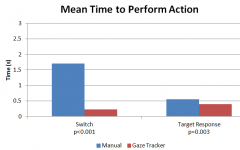In an article in “Ergonomics in Design“, a quarterly peer-reviewed publication of the Human Factors and Ergonomic Society, researchers published a report on a project they undertook at the Naval Surface Warfare Center, Dahlgren Division, in the US, to study the use of gaze recognition to control the switching between screens in a simulated video security system. The conclusion was that gaze was faster and produced a lower subjective workload than keyboard operation.

In the project, an EyeGaze eye tracker from LC Technologies was used to track where the user was looking. This point of gaze was used to choose between one of four views available and the choice confirmed with the keyboard. The alternative was to use the keyboard to select between the views, with the same confirmation. 12 participants took part.
The researchers found that the speed was better than it had predicted using a standard (KOL-GOMS) prediction method. The mean time for the gaze method was 0.87s (sd 0.12s), compared to 2.11s (sd 0.27s) for the keyboard only method. The gaze system proved to be faster than predicted, while the keyboard method was in line with the prediction.

There was no difference in accuracy between the two methods. The group acknowledged that moving the keys to the numeric keypad (they used the standard keys at the top of the keyboard) might have improved speed, but point out that the KOL-GOMS method does not predict an improvement.
The group found that there was a slightly slower time to recognise the target with the gaze (0.55s) than with the keyboard (0.4s), but it was not clear what the cause for this was.
The article is available online for a fee.
Analyst Comment
I have been a proponent of the idea of using gaze recognition as a way of controlling PC operations for some time now. There are practical barriers to overcome – at the moment the equipment costs more than it needs to for mass adoption, but that is largely a matter of “chicken and egg”. If there was mass adoption, costs and prices would come down dramatically as the technology moved from a human factors research tool to a productivity aid. If the price came down dramatically, there could be mass adoption.
As I have said before, it can be argued that Apple’s massive success with the iPhone was about transforming the user experience. The PC industry is currently, at best, becalmed and needs a big kick to usability and the user experience to drive more growth. In my view, gaze remains the best option for transforming the user experience. It needs coordination between hardware and software, but could make a real difference to productivity in many PC-based applications. It’s great to see good published research that backs up the productivity gains from gaze use. Bob Raikes

